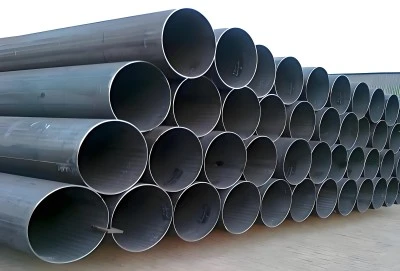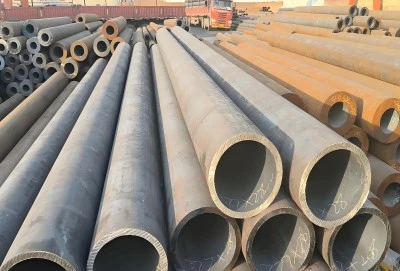S275JR steel pipe has become a crucial component in various industrial applications, particularly when it comes to compliance with EN 13480 and PED standards. These pipes, known for their excellent mechanical properties and versatility, play a significant role in ensuring the safety and efficiency of piping systems across multiple sectors. As we delve into the intricacies of S275JR pipes and their correlation with these essential standards, we'll uncover why they're a top choice for engineers and contractors worldwide.
|
|
|
EN 13480 Compliance: Key Points for S275JR
Material Properties of S275JR Steel for Piping Systems
S275JR steel is a low carbon structural steel grade that offers an ideal balance of strength, ductility, and weldability. Its chemical composition, typically containing 0.25% carbon, 1.60% manganese, and small amounts of silicon, phosphorus, and sulfur, contributes to its excellent formability and machinability. These properties make S275JR steel pipes particularly suitable for use in various piping systems, especially those requiring compliance with EN 13480 standards.
The yield strength of S275JR steel, at a minimum of 275 MPa, ensures that pipes made from this material can withstand significant pressure and loads. This strength, combined with its good impact resistance at room temperature, makes it an excellent choice for industrial piping applications where reliability is paramount.
EN 13480 Design Criteria for S275JR Steel Pipes
EN 13480, the European standard for metallic industrial piping, sets forth specific design criteria that S275JR steel pipes must meet. These criteria cover aspects such as wall thickness calculations, allowable stresses, and design temperatures. When designing piping systems using S275JR pipes, engineers must consider factors like internal and external pressures, thermal expansion, and potential environmental impacts.
The standard also outlines requirements for pipe dimensions and tolerances, ensuring consistency and interchangeability across different manufacturers. This standardization is crucial for large-scale projects where components may be sourced from multiple suppliers.
Testing and Inspection Requirements for S275JR Compliance
To ensure compliance with EN 13480, S275JR steel pipes undergo rigorous testing and inspection procedures. These include non-destructive testing methods such as ultrasonic testing and radiographic examination to detect any potential flaws or defects in the pipe material or welds. Mechanical tests, including tensile strength and impact tests, are also conducted to verify that the pipes meet the required mechanical properties specified in the standard.
Additionally, dimensional checks and visual inspections are carried out to ensure that the pipes meet the specified tolerances and surface finish requirements. These comprehensive testing and inspection procedures help guarantee the quality and reliability of S275JR steel pipes used in industrial piping systems.
PED Requirements: S275JR Pipe Certification Process
Essential Safety Requirements for S275JR Pipes under PEDThe Pressure Equipment Directive (PED) 2014/68/EU sets out essential safety requirements for pressure equipment and assemblies. For S275JR steel pipes to be used in pressure equipment, they must meet these stringent safety standards. The PED focuses on protecting against various hazards associated with pressure, including material failure, leakage, and excessive deformation.
S275JR pipes must demonstrate adequate strength, both in normal operating conditions and in reasonably foreseeable emergency situations. The material properties of S275JR steel, including its ductility and toughness, are crucial in meeting these safety requirements. The PED also mandates that the pipes be designed with appropriate safety factors, taking into account various modes of failure and the intended use of the equipment.
Conformity Assessment Procedures for S275JR Steel Pipes
The PED outlines several conformity assessment procedures for pressure equipment, including S275JR steel pipes. The specific procedure depends on the category of the equipment, which is determined based on factors such as the maximum allowable pressure, volume, and potential hazards.
For S275JR pipes, common assessment procedures might include quality assurance of the production process, product verification, or unit verification. These procedures involve thorough documentation of the design, manufacturing processes, and material properties. Third-party notified bodies often play a role in these assessments, providing independent verification of compliance with PED requirements.
CE Marking Process for PED-Compliant S275JR Pipes
Once S275JR steel pipes have successfully undergone the conformity assessment procedure, they can be CE marked, indicating compliance with the PED. The CE marking is a crucial step, as it allows the pipes to be legally placed on the European market and used in pressure equipment applications.
The CE marking process involves creating a declaration of conformity, which details how the pipes meet the essential safety requirements of the PED. This declaration, along with the technical documentation and the results of the conformity assessment, form the basis for the CE marking. The manufacturer must affix the CE marking visibly, legibly, and indelibly to each S275JR pipe or its data plate.
Harmonizing Standards: S275JR in Global Projects
S275JR Pipes in Oil and Gas Transportation ProjectsIn the oil and gas industry, S275JR steel pipes have found widespread use in transportation projects. Their ability to withstand high pressures and resist corrosion makes them ideal for pipelines carrying crude oil, natural gas, and refined products. These pipes are often used in conjunction with protective coatings to enhance their durability in harsh environments.
Global oil and gas projects, particularly in regions like the Middle East and Southeast Asia, frequently specify S275JR pipes due to their reliability and cost-effectiveness. The pipes' compliance with international standards like EN 13480 and PED ensures that they meet the stringent safety and quality requirements of these high-stakes projects.
Application of S275JR in Offshore Platform Construction
Offshore platforms represent another critical application area for S275JR steel pipes. These structures face unique challenges, including exposure to saltwater, extreme weather conditions, and constant movement. S275JR pipes are used in various systems on offshore platforms, from structural supports to process piping.
The material's good weldability is particularly advantageous in offshore construction, where on-site welding is often necessary. Additionally, the pipes' compliance with relevant standards provides assurance to operators and regulators alike, crucial in the high-risk offshore environment.
S275JR Steel Pipes for Bridge and Building Structures
Beyond industrial applications, S275JR steel pipes play a significant role in civil engineering projects, particularly in bridge and building construction. Their high strength-to-weight ratio makes them an excellent choice for structural elements in both temporary and permanent structures.
In bridge construction, S275JR pipes are often used in truss structures or as support columns. For buildings, they can be found in frameworks, especially in large industrial or commercial structures. The pipes' compliance with standards like Eurocode 3 ensures their suitability for these critical structural applications.
Where to Buy S275JR Steel Pipes?
When it comes to sourcing high-quality S275JR steel pipes, Hebei Longma Group stands out as a leading manufacturer. With advanced production equipment imported from Germany and independently developed technologies, Longma Group ensures top-notch quality in every pipe produced. Their professional team of over 300 employees, including 60+ technical experts, guarantees expertise in every aspect of production.
Longma Group provides complete certification, including API 5L, ISO 9001, ISO 14001, and FPC certificates, ensuring compliance with international standards. Their competitive pricing, made possible by long-term partnerships with raw material suppliers and an integrated production model, makes them an excellent choice for cost-effective, high-quality S275JR pipes.
For more information or to place an order, contact us at info@longma-group.com.














